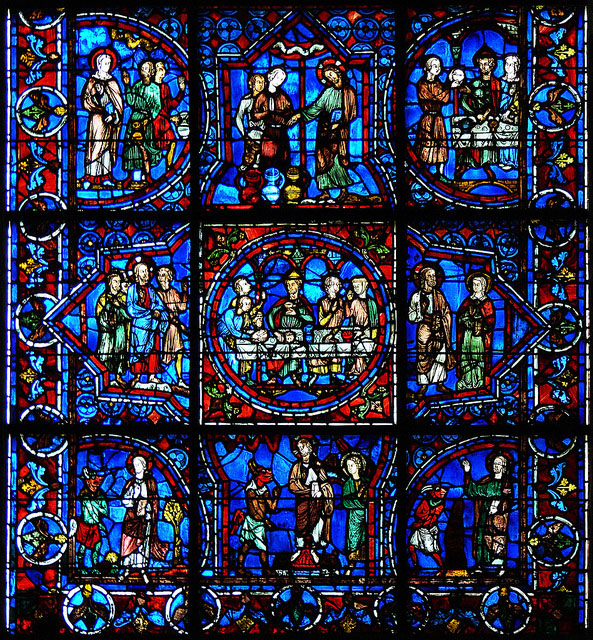Blue Virgin

Set into a 13th century window, in the south ambulatory of the choir (bay 44) of Chartres Cathedral, this is one of the most celebrated medieval artworks in the Cathédrale Notre-Dame de Chartres.It dates primarily to c. 1180 CE, with later additions around 1225 CE, making it a rare survivor from the pre-1194 fire that destroyed the earlier Romanesque cathedral. Famed for its luminous 'Chartres blue', a deep cobalt hue achieved with sodium-based cobalt oxide, more durable than contemporary reds and greens, the window exemplifies High Gothic artistry, blending Romanesque solidity with emerging Gothic narrative elegance.
The four central panels, of the upper register, depict the Virgo in Maestatis (Throne of Wisdom) typology, a Byzantine-influenced icon of Mary as the seat of divine wisdom. Seated majestically on a throne, the Virgin Mary (in radiant blue robes) holds the Christ Child on her lap, who raises his right hand in blessing while grasping a book of scriptures in his left. Mary's crown and halo, edged in gold, emphasize her queenship, while a dove (Holy Spirit) hovers above, symbolizing the Incarnation. Flanking them are six adoring angels in flowing garments of blue and red, some playing musical instruments or swinging censers, their wings and halos creating a celestial court. The composition's symmetry and jewel-like colors evoke heavenly harmony, with Mary's serene gaze inviting contemplation.

The lower register is a narrative section that illustrates a key episodes from Christ's early ministry. The upper six panels relate the Marriage at Cana. Top left the Virgin Mary and Jesus are invited to the wedding at Cana, next Jesus gestures toward the flasks of wine initiating the miracle, finally the wine is served. Below this is the Entry into Jerusalem, The Last Supper, and Touch Me Not. The bottom row depicts the Temptations of Christ in the Wilderness (Matthew 4:1–11, Luke 4:1–13).
The window's survival—spared from the 1194 fire that gutted much of the old cathedral—highlights its perceived miraculous quality, earning it devotion as a Black Madonna-like icon (though Mary here is vividly colored). Restored in the 13th century after partial damage, it integrates seamlessly into Chartres' ensemble of 176 windows, which narrate salvation history for the illiterate faithful. The "blue virgin" moniker stems from the intense azure that bathes Mary, a technical marvel using imported cobalt that filters light to create a transcendent glow. Theologically, it underscores Mary's role as Theotokos (God-bearer) and mediatrix, themes central to 12th-century Marian devotion amid scholastic debates.